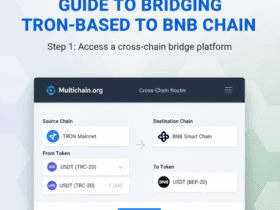In this post , I will focus on the Best Crypto Bridges for Beginners as well as the most seamless and safe options for moving assets between blockchains.
All the way from Ethereum and Solana to the Layer 2 networks, the bridges I will discuss here provide intuitive designs, inexpensive costs, and quick transfers.
These are great to access all cross-chain functionalities for novices in DeFi, NFTs, and so much more.
Key Points & Best Crypto Bridges For Beginners with Step-by-Step Guide
| 🔗 Bridge Name | 🧭 Key Features & Highlights |
|---|---|
| Across Protocol | Fast transfers, low fees, Ethereum-focused, supports L2s like Arbitrum and Optimism |
| Wormhole | Cross-chain messaging, supports Solana, Ethereum, BNB Chain, and more |
| Stargate Finance | Native asset bridging, deep liquidity, integrated with LayerZero |
| Synapse Protocol | Multi-chain swaps, stablecoin bridging, supports over 15 chains |
| Hop Protocol | Rollup-to-rollup transfers, fast finality, supports ETH, USDC, DAI |
| Celer cBridge | Wide chain support, fast and secure transfers, good UI for beginners |
| ChainPort | Custodial bridge with high security, supports over 40 blockchains |
| LI.FI Protocol | Aggregator of bridges and DEXs, smart routing for best rates |
| Multichain (Anyswap) | Supports 70+ chains, large token selection, widely used in DeFi |
| Portal Bridge (by Wormhole) | Token transfers and NFT bridging, user-friendly interface for Solana users |
10 Best Crypto Bridges For Beginners With Step-by-Step Guide
1. Across Protocol
Across Protocol is a fast, low-cost bridge designed for transferring assets between Ethereum and Layer 2 networks like Arbitrum and Optimism.
To use it, visit Across.to, connect your wallet (e.g., MetaMask), and select the source and destination chains. Choose the token and amount you want to bridge, then confirm the transaction.

Across uses a relayer system to ensure fast finality and low fees, often completing transfers in under five minutes. It’s ideal for beginners due to its simple interface and reliable performance.
Features Across Protocol
- Transfers are instantaneous between Ethereum and Layer 2 chains like Arbitrum and Optimism.
- Low transferring and bridging costs thanks to an efficient relayer system.
- Clear and easy to use.
- Secure with optimistic verification.
- Core tokens supported – ETH, USDC, DAI, and WBTC.
2. Wormhole
Wormhole is a cross-chain messaging protocol that supports transfers between Ethereum, Solana, BNB Chain, and more.
To bridge assets, go to the Wormhole Portal, connect your wallet, and select the source and target chains.

Choose the token and amount, approve the transaction, and confirm the bridge. Wormhole automatically adjusts your wallet’s network, making it beginner-friendly. It’s especially useful for Solana users looking to interact with EVM-compatible chains.
Wormhole
- Interoperability and cross-chain messaging with 20+ chains.
- Best functionality for transfers from Solana to EVM chains.
- Token and NFT bridging supported.
- Secured with decentralized guardian systems.
- Includes features for developers like SDKs and other integrations.
3. Stargate Finance
Stargate Finance makes it possible to bridge native assets across Ethereum, BNB, and Arbitrum. To use it, visit Stargate, connect your wallet, and select the token and networks.
Type the amount, check slippage and fee values, and confirm the transaction. Stargate is the only service to use unified liquidity pools.

As a result, transfers are seamless and efficient because there is no token wrapping. It is perfect for transfers that involve stablecoins, particularly USDC and USDT, because it performs the transfers quickly and at a competitive fee.
Stargate Finance
- Native asset bridging with no wrapped tokens.
- Abundant liquidity pools for stablecoins.
- Built on LayerZero for enhanced interoperability.
- Reduced slippage with quick execution.
- Supports Ethereum, BNB, Arbitrum, and Optimism chains.
4. Synapse Protocol
Synapse Protocol is the most flexible bridge that allows across more than 20 blockchains, gaining particular popularity for stablecoin swaps.
To use it, go to the Synapse dApp, connect your wallet, and select the source and destination chains. Choose your token (e.g., USDC, USDT), input the amount, and confirm the transaction.

To facilitate transfers, Synapse uses liquidity pools and wrapped assets. It is the most user-friendly for those new to DeFi because it has an simple interface and extensive chain support, which makes it easy to move assets between various DeFi systems.
Synapse Protocol
- 20+ blockchain supported like Ethereum, Avalanche and BNB.
- Fee swaps on stablecoins with seamless transactions.
- Designed for ease of use for beginners.
- Secure bridging with liquidity pools.
- Delivers cross-chain messaging and smart contracts call.
5. Hop Protocol
Hop Protocol offers fast and trustless transfers between Ethereum and Layer 2 networks including Optimism, Arbitrum, and Polygon.
To do a Hop transfer, navigate to Hop Exchange, connect your wallet, select your token and chains, input an amount, approve the transaction, and confirm the bridge.

Hop offers near-instant transfers because of its liquidity providers and bonding mechanism.
This protocol is great for users that move assets between rollups frequently and is tailored to beginners because of its straightforward design.
Hop Protocol
- Rollup-to-rollup bridging (Optimism, Arbitrum, Polygon)
- Fast finality with bonding mechanism
- Low fees and minimal slippage
- Clean UI for easy navigation
- Supports ETH, USDC, DAI, and MATIC
6. Celer cBridge
Celer cBridge offers fast, secure, and inexpensive cross-chain transfers for over 30 blockchains.
To use cBridge, visit the app, connect your wallet (Trust Wallet, MetaMask, etc.), select your source and destination chains, token, and amount, approve the transaction, and confirm.

To maintain speed and security, cBridge leverages the Celer Inter-chain Messaging (IM) framework.
This is perfect for users that want a broader selection of chains and tokens because the clean interface is tailored for beginners.
Celer cBridge
- Supports 30+ blockchains including Ethereum, BNB, and Avalanche
- Fast and secure transfers using Celer IM framework
- User-friendly interface with clear steps
- Offers both token and smart contract bridging
- Real-time analytics and transaction tracking
7. ChainPort
ChainPort is a custodial bridge that prioritizes security and supports more than 40 blockchains.
To bridge assets, visit ChainPort, connect your wallet, and select the token and the destination chain.

Approve the transaction and wait for a confirmation. ChainPort simplifies the technical side of the process, keeping it beginner friendly.
This bridge is particularly useful for projects and users that want to securely port tokens over several ecosystems and value a seamless experience with low friction.
ChainPort
- Custodial bridge with high security standards
- Supports 40+ blockchains including niche networks
- Automated porting with minimal user input
- Ideal for projects and token issuers
- Beginner-friendly dashboard and walkthroughs
8. LI.FI Protocol
LI.FI is a bridge and DEX aggregator that optimizes the route for your cross-chain swaps. Use a dApp that integrates with LI.FI, such as Jumper Exchange, connect your wallet, and specify the source and destination chains.
Afterwards, select your token and amount and LI.FI will recommend the most efficient bridge and swap route. You will have to confirm the transaction with your wallet.

LI.FI is excellent for users that are new to this technology, as it aggregates all the necessary tools and eliminates the need to manually compare different bridges.
It supports more than 30 chains and partners with key DeFi protocols, facilitating the most effective range of movement and transaction routing.
LI.FI Protocol
- Aggregates multiple bridges and DEXs for best routing
- Smart pathfinding for optimal fees and speed
- Supports 30+ chains and thousands of tokens
- Developer tools and SDKs for integration
- Clean UI with swap and bridge in one flow
9. Multichain (formerly Anyswap)
Multichain is one of the most used decentralized bridges. It supports over 80 blockchains. To use the service, go to Multichain, connect your wallet, and select the token and source/destination chains. Enter the amount, approve, and confirm the transaction.

It uses Secure Multi-Party Computations (SMPC) nodes to validate transfers, which is great for users needing multichain support and an excellent bridging experience. It is also easy to use for beginners.
Multichain (formerly Anyswap)
- Over 80 blockchains supported including Fantom, Cronos, and others.
- Secure MPC node architecture.
- User-friendly token bridging interface.
- Diverse tokens and liquidity available.
- Extensive use in DeFi protocols and dApps.
10. Portal Bridge (by Wormhole)
Portal Bridge is Wormhole’s token bridge. It allows users to move tokens freely between Ethereum, Solana, and over 20 other chains.
To use it, go to PortalBridge.com, connect your wallet, and select the asset and chains to enter the amount, approve the transaction, and confirm.

Portal Bridge allows users to transfer both tokens and NFTs. It is an excellent option for users who want to transfer assets between Solana and EVM-compatible chains.
Portal Bridge (by Wormhole)
- Token bridge that uses Wormhole infrastructure.
- Transfers tokens and NFTs.
- Step-by-step beginner-friendly interface.
- Interlinks Solana, Ethereum, BNB, and others.
- Guardian network for decentralized validation.
Conclsuion
In conclsuion Crypto bridges nable easy moviment of assets across blockchains, thus opening new opportunities in DeFi, NFTs, and trading.
As a beginner, Across, Wormhole, and Stargate are great options, providing fast, safe, and easy to use interfaces.
These bridges help you cross chains without complication with their simple processes and extensive chain support.
You can now cross chains at a level of ease previously unseen. Pick smart and bridge with trust.
FAQ
A crypto bridge allows you to transfer assets between different blockchains (e.g., Ethereum to Solana).
Bridges help you access DeFi, NFTs, and apps on other chains without selling or swapping your tokens.
Most top bridges use secure protocols, but always verify the site and use trusted wallets
MetaMask is widely supported; Solana bridges may require Phantom or other Solana-compatible wallets.
Connect your wallet, choose source and destination chains, select token and amount, then confirm.














Leave a Reply